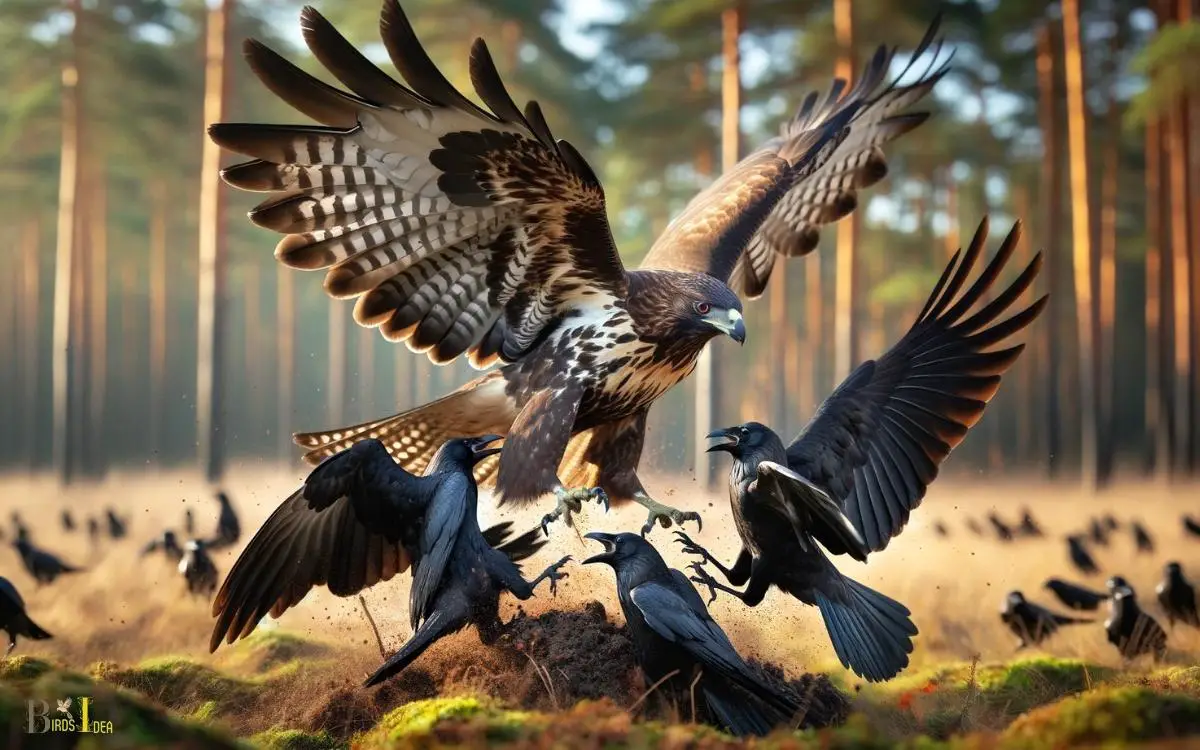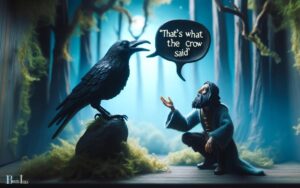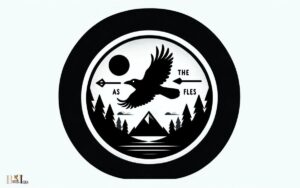What Are Crows Natural Predators: Hawks, Eagles, and Owls!
Crows face predation from a variety of species, including larger birds of prey like hawks, eagles, and owls.
Mammalian predators such as raccoons, snakes, and even domestic cats pose a threat, particularly to eggs and young crows.
Crows are intelligent and adaptable birds, but they are not at the top of the food chain.
Their natural predators include:
Birds of Prey: These are the most formidable predators of adult crows and include:
- Red-tailed Hawks
- Great Horned Owls
- Bald Eagles
Mammals: These predators often attack crow nests to eat their eggs or fledglings:
- Raccoons
- Foxes
- Cats
Reptiles: Snakes can also be a threat to crow nests.
For example, the Great Horned Owl, being nocturnal, can catch crows off guard during the night.
Despite their cleverness and social structures, crows remain vulnerable to natural predation, which plays a crucial role in the balance of our ecosystems.

Key Takeaway
Avian Predators
Avian predators, such as hawks and owls, are key natural threats to crows. These birds of prey pose a significant danger to crows, targeting them as a food source.
- Hawks, with their swift and agile flight, are adept hunters, while owls, with their silent flight and powerful talons, are formidable nocturnal predators.
- Crows have developed various strategies to evade these avian predators, including mobbing behavior, where they collectively harass and drive away the threatening birds.
- Crows are known for their intelligence and problem-solving abilities, which they use to outsmart their avian adversaries.
- Despite these challenges, crows have thrived in various environments, demonstrating their resilience in the face of natural threats.
Understanding the dynamics between crows and their avian predators provides valuable insight into the complex interplay of species in the natural world.
Mammalian Predators
Mammalian predators also pose a significant threat to crows, with species such as foxes, raccoons, and domestic cats preying on them as a food source.
These predators are known for their agility and hunting skills, making them formidable threats to crows in various environments.
The following table illustrates some common mammalian predators of crows:
| Mammalian Predators | Description | Threat Level |
|---|---|---|
| Foxes | Highly adaptive and skilled hunters | High |
| Raccoons | Opportunistic feeders with sharp claws | Moderate |
| Domestic Cats | Agile hunters that often hunt for sport | Low |
These predators pose a constant risk to crows, particularly during nesting seasons or when food sources are scarce.
Despite this, crows have developed various strategies to evade mammalian predators, such as nesting in high or inaccessible locations.
Moving on to the next subtopic, let’s explore the threats posed by reptilian predators.
Reptilian Predators
Crows face potential threats from reptilian predators due to their ability to access nesting sites and capture young or vulnerable individuals.
Snakes, such as rat snakes and black racers, are known to climb trees and raid crow nests for eggs and chicks.
Additionally, larger reptiles like monitor lizards and alligators may pose a threat to crows and their offspring.
Reptiles’ agility, stealth, and keen sense of smell enable them to locate and exploit crow nests, making them formidable predators.
It is crucial for crows to remain vigilant and employ defensive strategies to protect their nests and young from these reptilian threats.
Understanding the behavior and habitats of reptilian predators can help crows adapt and enhance their survival in the face of these challenges.
Insect Predators
Insect predators play a significant role in the natural balance of ecosystems. Birds, such as the European Bee-Eater and the Purple Martin, are known for their insect-eating habits, impacting the population of various insect species.
This dynamic interaction between birds and insects contributes to the ecological balance in nature.
Birds as Predators
The avian predators’ role in controlling insect populations is significant and contributes to the ecological balance of various ecosystems.
- Birds such as swallows, warblers, and flycatchers are known for their insect-eating habits.
- These birds play a crucial role in keeping insect populations in check, thus preventing outbreaks that could harm vegetation and crops.
- Their foraging behavior helps to control pests that can damage agricultural produce and forests.
- Birds that consume insects also aid in pollination and seed dispersal, further supporting the health and diversity of plant life.
- This natural form of pest control reduces the need for chemical pesticides, promoting a more sustainable and balanced environment.
By preying on insects, birds contribute to the overall health and stability of ecosystems, showcasing the interconnectedness of species in nature.
Impact on Population
Having established the significance of birds as insect predators, their impact on population control within various ecosystems becomes evident through the maintenance of ecological balance and the prevention of pest-related damages to vegetation and crops.
- Birds, particularly crows, play a crucial role in regulating insect populations, thus preventing outbreaks that could cause significant harm to agricultural and natural environments.
- By preying on insects, birds help to keep their populations in check, which in turn supports the overall health of ecosystems.
- This natural form of pest control reduces the need for chemical pesticides, benefiting both the environment and human health.
- By controlling insect populations, birds contribute to the preservation of biodiversity by preventing the dominance of certain insect species that could otherwise disrupt the delicate balance within ecosystems.
This delicate balance is essential for the overall health and sustainability of the environment.
Ecological Balance
Crows, as natural predators, play a vital role in maintaining ecological balance by regulating insect populations, thus preventing outbreaks that could cause significant harm to agricultural and natural environments.
By preying on insects, crows help in controlling their numbers, which in turn safeguards crops and reduces the spread of diseases carried by certain insects.
This ecological balance is crucial for preserving the freedom of natural habitats and ensuring the sustainability of agricultural practices.
Here is a table illustrating the impact of crows as insect predators:
| Ecological Impact | Benefit | Explanation |
|---|---|---|
| Pest Control | Yes | Crows help in controlling pest insect populations. |
| Ecosystem Health | Yes | Regulating insect numbers maintains the balance in the ecosystem. |
| Agricultural Support | Yes | By reducing insect damage, crows aid in preserving agricultural freedom. |
Aquatic Predators
- Crows can fall victim to aquatic predators such as alligators and large fish.
- Alligators, known for their powerful jaws and stealthy hunting techniques, pose a significant threat to crows near water bodies.
- They can snatch unsuspecting crows from the water’s edge or even catch those flying low over the water.
- Large fish, such as pike or muskellunge, are also potential aquatic predators of crows, especially when the birds are foraging near the water’s surface.
- These predators rely on the element of surprise to catch their prey, making crows vulnerable when they are near aquatic habitats.
Understanding the threats posed by aquatic predators is crucial in comprehending the challenges crows face in their natural environment.
This leads us to the subsequent section about human predation.
Human Predation
- Human predation poses a significant threat to crows, impacting their survival and behavior in their natural habitats.
- While historically, crows have been hunted for various reasons, including crop protection and sport, the increased urbanization and habitat destruction have brought humans and crows into closer contact, leading to conflicts.
- Crows are often considered pests and are subjected to lethal control methods, such as shooting, trapping, and poisoning.
- Furthermore, urban development has led to an increase in vehicle collisions and power line electrocutions, resulting in significant mortality among crow populations.
- Beyond direct killing, human activities also contribute to habitat destruction, pollution, and climate change, which can affect the availability of food and nesting sites for crows.
These factors collectively contribute to the vulnerability of crow populations to human predation.
Moving on to ‘unusual predators’…
Unusual Predators
As we explore the natural predators of crows, it’s essential to consider the unexpected threats these birds face in their environment.
While traditional predators like hawks and owls are well-documented, there are also surprising dangers that pose a threat to crows’ well-being.
Examining unlikely crow predators sheds light on the complex web of interactions within their ecosystems.
Unlikely Crow Predators
One unusual predator of crows is the great horned owl, which has been known to prey on young or injured crows.
Despite being primarily nocturnal, these powerful owls are skilled hunters and have the advantage of stealth and silent flight, making them a threat to crows, especially during the night.
Another unexpected predator of crows is the domestic cat. While they may seem more interested in small mammals, birds, including crows, are also on their menu.
In urban and suburban areas, where crows often forage for food, domestic cats pose a significant risk to their population.
These unlikely predators serve as a reminder that crows face threats from a variety of sources, not all of which are immediately apparent.
Moving forward, it’s important to consider the surprising threats to crows.
Surprising Threats to Crows
Unforeseen by many, the presence of uncommon predators poses a significant threat to crows in various environments.
Surprisingly, these unusual predators include:
Great Horned Owls
These nocturnal hunters have been known to prey on crows, using their stealth and sharp talons to catch them off guard.
Despite crows being highly intelligent and agile, they are vulnerable to attacks from above when roosting or nesting.
Raccoons
Raccoons are opportunistic feeders and have been observed raiding crow nests for eggs and chicks.
Their dexterity and intelligence enable them to outmaneuver and outwit crows, posing a serious threat to their offspring.
These unexpected predators highlight the diverse range of challenges that crows face in their natural habitats, demonstrating the complex interplay between species.
Moving forward, it is crucial to explore the unexpected dangers for crows.
Unexpected Dangers for Crows
The presence of unexpected predators poses a significant threat to crows in various environments, highlighting the diverse range of challenges that they face in their natural habitats.
- While crows are known to face threats from traditional predators such as hawks, owls, and raccoons, they also encounter unexpected dangers.
- Domestic cats and dogs, for instance, can pose a significant threat to crows, especially in urban and suburban areas where these pets roam freely.
- Larger birds such as eagles and vultures can occasionally pose a danger to crows, especially during territorial disputes or competition for food sources.
- Furthermore, human activities, including vehicle collisions and accidental poisoning from pesticides, also present unexpected dangers to crow populations.
These unusual predators underscore the complex and varied threats that crows must navigate in their natural environments.
What Eats a Crow?
Crows, being relatively large birds, have a few natural predators.
Some of the potential predators of crows include:
- Birds of Prey: Larger raptors such as eagles, hawks, and owls may prey on crows, especially young or vulnerable individuals.
- Mammals: Larger mammals, such as foxes, raccoons, and domestic cats, may pose a threat to crows, especially when they are nesting on the ground or in a vulnerable position.
- Other Birds: Intraspecific predation, or predation by other crows, is not uncommon. Crows may attack and kill each other, particularly in territorial disputes.
- Humans: While not natural predators, humans can pose a threat to crows through activities such as hunting, trapping, or habitat destruction.
It’s important to note that crows are highly intelligent and social birds, and they have developed various strategies to avoid predation, such as mobbing behavior where they collectively attack and drive away potential threats.
Crows are opportunistic feeders and scavengers, which helps them survive in a variety of environments.
Conclusion
The natural predators of crows span across various species, including avian, mammalian, reptilian, insect, aquatic, and human predators.
These predators play a crucial role in the ecosystem, maintaining a balance in the population of crows and other species.
Just as in the circle of life portrayed in the natural world, the presence of these predators serves as a reminder of the intricate web of life and the interconnectedness of all living beings.






